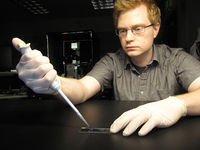Andy Maloney: Difference between revisions
From Santa Fe Institute Events Wiki
(Created page with '{{Complex Systems Summer School 2014}} I am a biophysicist working in the College of Pharmacy at The University of Texas at Austin.') |
No edit summary |
||
| Line 1: | Line 1: | ||
{{Complex Systems Summer School 2014}} | {{Complex Systems Summer School 2014}} | ||
I | [[File:andy_maloney.jpg|200px]] | ||
== About == | |||
I received my PhD in physics from the University of New Mexico where I studied the motor protein kinesin-1. The above picture is me running a gliding motility assay using kinesin-1 and microtubules. You can check out what a gliding motility assay is [http://youtu.be/QU8XRqVdFk0 here]. My research focused on modifying the solvent of the assay—typically with heavy water—to adjust the speed at which kinesin-1 moved across microtubules in order to investigate hydration of the proteins. My current research at The University of Texas at Austin in the College of Pharmacy investigates fluid flow using Particle Image Velocimetry techniques of inhalers, the kind used to treat asthma. While my background has been heavily weighted towards experimental optical techniques to observe physical systems, I've been fascinated with the computational techniques used to find interesting results from networks. | |||
My time at the CSSS course will be to obtain a greater understanding of networks so that I can apply what I learn to public health related problems, specifically with the medications we take. We tend to think that a medication is specifically designed for one target, however, drugs can bind off their targets causing side-effects. Sometimes side-effects can be good as was the case for Viagra, which was initially studied for hypertension until the test subjects reported an interesting—and extremely fascinating—side-effect. Side-effects are not always good and can cause severe problems, which can be compounded by multiple drug use. Polypharmacy, as it is called, can cause many problems among elderly patients who are the largest patient population that takes multiple medications. Why some drugs interact with each other to cause severe side-effects (thus making their recommended use together prohibited) has not been fully explored. It could be that the drugs are binding to the same off target sites, which compound the side-effect, or it could be because one medication contains a product that has been shown to interact with the other drug. These are interesting questions that I believe can be answered by using the calculus of networks and more importantly, can be directly applied to enhancing public health through these observations. | |||
== Expertise == | |||
* Python | |||
* NetworkX | |||
* Online collaborative tools | |||
* Open science | |||
== Contact == | |||
* [[Special:Emailuser/Maloneya|Click here to email me using the wiki.]] | |||
Latest revision as of 05:26, 12 June 2014
| Complex Systems Summer School 2014 |
About
I received my PhD in physics from the University of New Mexico where I studied the motor protein kinesin-1. The above picture is me running a gliding motility assay using kinesin-1 and microtubules. You can check out what a gliding motility assay is here. My research focused on modifying the solvent of the assay—typically with heavy water—to adjust the speed at which kinesin-1 moved across microtubules in order to investigate hydration of the proteins. My current research at The University of Texas at Austin in the College of Pharmacy investigates fluid flow using Particle Image Velocimetry techniques of inhalers, the kind used to treat asthma. While my background has been heavily weighted towards experimental optical techniques to observe physical systems, I've been fascinated with the computational techniques used to find interesting results from networks.
My time at the CSSS course will be to obtain a greater understanding of networks so that I can apply what I learn to public health related problems, specifically with the medications we take. We tend to think that a medication is specifically designed for one target, however, drugs can bind off their targets causing side-effects. Sometimes side-effects can be good as was the case for Viagra, which was initially studied for hypertension until the test subjects reported an interesting—and extremely fascinating—side-effect. Side-effects are not always good and can cause severe problems, which can be compounded by multiple drug use. Polypharmacy, as it is called, can cause many problems among elderly patients who are the largest patient population that takes multiple medications. Why some drugs interact with each other to cause severe side-effects (thus making their recommended use together prohibited) has not been fully explored. It could be that the drugs are binding to the same off target sites, which compound the side-effect, or it could be because one medication contains a product that has been shown to interact with the other drug. These are interesting questions that I believe can be answered by using the calculus of networks and more importantly, can be directly applied to enhancing public health through these observations.
Expertise
- Python
- NetworkX
- Online collaborative tools
- Open science

